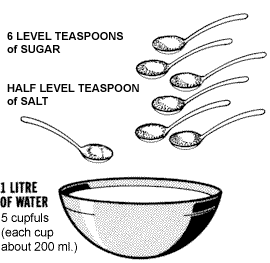We brought to you a report on food poisoning last week. We noted that incidence of food poisoning caused by the contamination of food and drinks by bacteria, viruses, parasites or chemical substances, resulting into mild and or severe health challenges including diarrhea, vomiting and tummy cramps, has become a global challenge. We shared, with you, the reports of World Health Organization (WHO) & World Bank on global burden of foodborne disease. We discussed the productivity loss associated with foodborne disease in low- and middle-income countries which, according to the World Bank figure, was estimated to cost US$ 95.2 billion per year. The annual cost of treating foodborne illnesses, according to WHO estimation, we noted, is US$ 15 billion.
Apart from revealing how you can contaminate your foods and water, our report, “Beware of food poisoning” also emphasized the high risk of consumption of herbal mixture to food poisoning as the herbs might conceal bacteria and other germs while the local mixing processes might also not follow the required hygiene standards.
To catch-up visit https://www.citizencomfort.com/2021/07/12/beware-of-food-poisoning/
To take the issue of food safety further, let’s start with the key facts of food poisoning.
- Access to sufficient amounts of safe and nutritious food is key to sustaining life and promoting good health.
- Unsafe food containing harmful bacteria, viruses, parasites or chemical substances, causes more than 200 diseases – ranging from diarrhoea to cancers.
- An estimated 600 million – almost 1 in 10 people in the world – fall ill after eating contaminated food and 420 000 die every year, resulting in the loss of 33 million healthy life years (HLYs) that is number of years that a person is expected to continue to live in a healthy condition
- US$110 billion is lost each year in productivity and medical expenses resulting from unsafe food in low- and middle-income countries.
- Children under 5 years of age carry 40% of the foodborne disease burden, with 125 000 deaths every year.
- Diarrhoeal diseases are the most common illnesses resulting from the consumption of contaminated food, causing 550 million people to fall ill and 230 000 deaths every year.
- Food safety, nutrition and food security are inextricably linked. Unsafe food creates a vicious cycle of disease and malnutrition, particularly affecting infants, young children, elderly and the sick.
- Foodborne diseases impede socioeconomic development by straining health care systems, and harming national economies, tourism and trade.
- Food supply chains now cross multiple national borders. Good collaboration between governments, producers and consumers helps ensure food safety.
Treatment (Home Remedy & When to See a doctor).
There is no doubting the fact that the above facts are frightening and require all hands to be on deck to fight the food poisoning scourge in order to prevent and or reduce food poisoning morbidity. But before we go into prevention procedure, lets discuss management procedure to guide food poisoning victims.
The day-to-day activities of the people in the low income/ developing countries like in Nigeria and in some economic hub cities of the developed countries are characterized by hustling and buzzling that make people spend more time outside their homes and thus make them eat all manners of food and drinks, mostly with unknown source(s); This is why a significant population of the world is at the risk of food poisoning.
Yes, we all are vulnerable to food poisoning; And, in case it happens, medical experts say we should do the following until symptoms ease:
Fluids – Drink and drink to prevent dehydration
- Drink at least 200 mls after each watery stool. This extra fluid is in addition to what you would normally drink. For example, an adult will normally drink about two litres a day but more in hot countries. The above ‘200 mls after each watery stool’ is in addition to this usual amount that you would drink. If you vomit, wait 5-10 minutes and then start drinking again but more slowly.
- To stay hydrated and replace the fluid you have lost, it’s important to drink water that has salt and sugar in it. For adults or older children, use an Oral Replacement Therapy (ORT), such as Ceralyte or Oralyte, available Over The Counter (OTC) in pharmacy shops. You can also make your own solution by adding 6 teaspoons of sugar and 0.5 teaspoons of salt to 1 liter of water.

- For infants, breastfeed continuously
- For children use babies’ formula with
- Avoid sports and energy drinks. They cannot properly correct fluid and electrolyte losses because of their high sugar content. In fact, they may even worsen your diarrhea.
Eat asap
-Medical experts advise you eat as soon as you are able – but don’t stop drinking.
– Avoid fatty, spicy or heavy food at first. Plain foods such as wholemeal bread and rice are good foods to try eating first.
Medication may help
Medical experts and journals say food poisoning that has not got to dehydration point may not need medication to ease, as the body system will try to get rid of the germs. But if the symptoms are becoming difficult to manage, the following OTC medication can help to ease the symptoms
-Antacid
-Anti-parasitic drugs
– Anti-diarrheal agents, like Imodium
-Paracetamol to ease headache symptom
When to See a doctor is that point that you feel dehydrated
Dehydration symptoms
- Thirst
- Dry or sticky mouth
- Not peeing very much
- Dark yellow pee
- Dry, cool skin
- Headache
- Muscle cramps
- Not peeing or having very dark yellow pee
- Very dry skin
- Feeling dizzy
- Rapid heartbeat
- Rapid breathing
- Sunken eyes
- Sleepiness, lack of energy, confusion or irritability
- Fainting
If you feel any or a combination of these symptoms after food poisoning attack, consult a medical doctor for proper management.
Prevention
Prevention, they say is better than cure. Here are some prevention tips to avoid / minimize the incidences of food poisoning.
The ‘4 Cs’ to help prevent food poisoning:
Cleanliness
- Keep surfaces and utensils clean.
- Wash and dry your hands regularly but especially after going to the toilet, before preparing food, after handling raw food and before touching ‘ready-to-eat’ food.
- Don’t prepare food for others if you have diarrhoea or
- Cover any sores or cuts on hands with a waterproof plaster before you touch food.
- Change dish cloths and towels regularly.
Cooking
- Make sure that you cook food thoroughly, especially meat. This will kill germs (bacteria).
- If you are reheating food, it needs to be cooked right .
- Don’t reheat food more than once.
- Use separate cooking utensils/plates for raw meat, poultry, and seafood.
Chilling
- Food that needs to be chilled or refrigerated should be. If food is left out of the fridge, bacteria may multiply to levels that can cause food poisoning.
- Your fridge needs to be kept between 0°C and 5°C. Also, don’t leave the fridge door open unnecessarily.
- Cool leftover food quickly and then refrigerate. Taking it out of the cooking pot and putting it into a shallow container can speed up the cooling process.
Cross-contamination
This occurs when bacteria pass from foods (commonly, raw foods) to other foods. It can occur if:
- Foods touch directly.
- One food drips on to another.
- Your hands or utensils or equipment such as knives or chopping boards touch one food and then another.
It is important to:
- Wash your hands after touching raw foods.
- Separate raw and cooked or ready-to-eat foods.
- Keep raw meat in a sealable container at the bottom of the fridge.
- Avoid using the same surface or chopping board for preparing raw and ready-to-eat foods.
- Make sure that knives and utensils are cleaned after preparing raw foods.
Other prevention tips include:
- Avoid unpasteurized milk and juices.
- Throw out foods that are past their expiration date, even if they do not smell “bad” or look “funny.” Many foods that are contaminated look and smell normal.
- Eat more of plant-based diet, as many bacteria/parasites are more common in meat and animal products.
- Follow food safety rules always.
Suffice here to say these preventive measures are at individuals and organizations levels. But food safety issues go beyond national frontiers. There are regional and international dimensions to food poison challenge. For example, the contamination of ready-to-eat meat in South Africa in 2017/18 killed216 people and infected 1060 people with listeriosis. These contaminated products were also exported to 15 other countries in Africa, requiring an international response to implement risk management measures.

International Food Safety Conference. credit fao.org
Global concern & WHO Intervention
Unsafe food poses global health threats, endangering everyone. Infants, young children, pregnant women, the elderly and those with an underlying illness are particularly vulnerable. UN reports that every year 220 million children contract diarrhoeal diseases and 96 000 die.
The International Conference on Food Safety held in Addis Ababa in February 2019, and the International Forum on Food Safety and Trade held in Geneva in 2019, reiterated the importance of food safety in achieving the Sustainable Development Goals. Governments, according to UN should make food safety a public health priority by:
- building and maintaining adequate food systems and infrastructures (e.g., laboratories) to respond to and manage food safety risks along the entire food chain, including during emergencies
- fostering multi-sectoral collaboration among public health, animal health, agriculture and other sectors for better communication and joint action;
- integrating food safety into broader food policies and programmes (e.g. nutrition and food security);
- thinking globally and acting locally to ensure that food produced domestically remains safe when imported internationally.
The World Health Organization (WHO) is strategically facilitating global prevention, detection and response to public health threats associated with unsafe food. The world health body is helping member states build capacity to prevent, detect and manage foodborne risks by:
- providing independent scientific assessments on microbiological and chemical hazards that form the basis for international food standards, guidelines and recommendations, known as the Codex Alimentarius, to ensure food is safe wherever it originates;
- assessing, in structured, transparent and measurable ways, the performance of food control systems throughout the entire food chain, identifying priority areas for capacity development, and measuring and evaluating progress over time through The FAO/WHO food control system assessment tool;
- assessing the safety of new technologies used in food production, such as genetic modification and nanotechnology.
- helping improve national food systems and legal frameworks, and implement adequate infrastructure to manage food safety risks.
- developing the International Food Safety Authorities Network (INFOSAN) and the UN Food and Agriculture Organization (FAO) to rapidly share information during food safety emergencies.
- promoting safe food handling through systematic disease prevention and awareness programmes.
- advocating for food safety as an important component of health security and for integrating food safety into national policies and programmes in line with the International Health Regulations (IHR – 2005).
WHO works closely with FAO, the World Organization for Animal Health (OIE) and other international organizations to ensure food safety along the entire food chain from production to consumption.
Publisher’s Note:
- Leave your comments in the comments box below and share the post
- Send your health- related articles, stories, tips to [email protected] for free publication
- Like and share our Facebook page: @citizencomfortng




Thank you @citizencomfort for this writeup.
If we can be a little less nonchalant in this country, it will be really helpful. Some people consume products 2-3 months after the expiry dates because they believe the producers add more allowance when writing expiry dates. Even if it’s true and allowances are added, I think it’s still very unwise to consume expired products